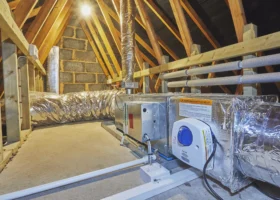
Early bird offer!
Claim your two free tickets here!
Early bird offer!
Claim your two free tickets here!The water that falls on our roofs can be collected, stored and used for a variety of purposes. The main use of harvested rainwater is to flush WCs, but it’s also fine for use in washing machines. It’s commonly used for outside taps, too, and is ideal for cleaning the car, pressure washing or watering the garden.
But is rainwater harvesting (RWH) a good choice for your self build, conversion or renovation, and what are the key considerations to note before specifying a system? Here, I’m taking a look at the ins and outs of rainwater harvesting – from the benefits to the costs and mains backup options.
Repurposing rainfall reduces your reliance on the mains supply, easing pressure on the system and lowering water bills if your property is metered. Additionally, rainwater is naturally soft, eliminating the need for water softeners in hard water areas. However, it’s important to note that harvested rainwater is not safe for personal hygiene purposes, such as handwashing, showering or bathing.
Rainwater harvesting also has a beneficial, if minor, effect on the drainage system, as it serves to hold water when it rains, rather than conveying it directly to sewers. Spells of heavy rainfall are expected to increase due to climate change, so the widespread adoption of RWH would contribute towards a lower flooding risk.
Roofs are typically the primary point for harvesting for two key reasons: they already have a collection system in place, such as guttering, and they have fewer contaminants than the ground. While leaves and moss can be removed with basic filtration, more sophisticated and sometimes self-cleaning systems are also available for filtering.
Harvested rainwater must have its own set of distribution pipes. There are legal standards for how rainwater conduits should be marked up, so they’re clearly identifiable and there’s no danger of harvested water being connected to a potable use, such as a handbasin, at a later date.
What is greywater?Greywater recycling is often confused with rainwater harvesting – but the two are very different. Greywater is the reuse of water that has been used for showers, hand washing and washing machines. It can’t be simply used around the home like rain; it has to undergo a process of cleansing in order to be useful. So in domestic installations, greywater is channeled to a treatment unit where it is filtered and disinfected. Once it has undergone this process it can be sent to a storage unit and linked up to WCs around the home. In general terms, daily supply per person will roughly equate to demand. While it’s not as popular as rain collection, greywater can boost your home’s sustainability credentials, reducing your mains use and therefore minimising your home’s environmental impact. There are a number of specialists in the UK such as Aquaco , Aqulility and WTS. |
Most RWH tanks are installed below ground, which makes it easy to channel water to them. Tanks can be unsightly, too, so they’re best hidden – plus digging them into the earth protects them from freezing. This does mean the water has to be pumped from the storage vessel, either straight to the points of use inside the property (a direct pressure system) or to a secondary header tank in the loft.
Rainwater tank sizing follows the law of diminishing returns: the larger the tank, the less frequently mains backup is needed, though the effect decreases with size.
A 1,500 to 2,000-litre tank typically covers most WC and washing machine needs in an average home – (1m³ = 1,000L). Suppliers, like Rainwater Harvesting, offer online calculators to estimate the right tank size, but it’s best to consult your provider’s expert team for optimal results.
To calculate the volume of water you can collect, you first need to determine the roof area in plan view (top-down), which is usually similar to the ground floor area of your house. You can find this from your house plans or by measuring. This area is the effective collection space, regardless of the roof’s pitch. Next, check the expected annual rainfall in your area per square metre, with estimates available on the Met Office website. For example, a house in the West Midlands averages 669mm (0.669m) of rainfall per year.
Let’s assume our West Midlands home is an average-sized, four-bed property of around 140m², with a ground floor area of 7m x10m (70m²). The available rainwater would then be 70 x 0.669 = 46.83m³. Not all of this water will actually be collected, as some is lost to evaporation and overflow. A good rule of thumb would be that you’ll end up with 80% of the yield. In this case, 46.83 x 0.80 gives us a result of 37.46m³. For context, data from water companies suggests the average four-bed household uses around 164m³ of water per year (including potable applications).
Average rainfall (m) x area of roof (m²)
|
For many houses, the roof shape will only allow harvesting on one side of the property, unless costly pipework is added to convey water through, or under, the building. If that’s the case for you, then you can halve the expected yield – so, with reference to our example house, it might deliver more like 18.7m³ of usable rainwater.
Every RWH system needs a mains backup to meet demand when there’s no rainwater in the tank. There are several ways to do this. A common arrangement for direct pressure systems, for instance, is to use a float switch inside the storage tank. This senses when the level reaches a critical low point and then opens the mains water feed to refill with a limited amount of mains water.
As the tank only partly refills, there’s plenty of room for water to be stored when it starts raining again. So, the system will always favour the collection and use of harvested rain when it is available. Mains backup must be correctly installed in accordance with the water regulations and to prevent back-contamination of the mains supply.
Communal water harvesting systemsCommunal systems (usually sited underground) pool rainfall from several properties. These are slightly more efficient than individual systems. They benefit from the averaging effects of multiple uses; a 10m³ tank serving a group of 10 properties should require less mains backup in prolonged periods of low rainfall than a 1m³ tank serving a single home. As there are economies of scale in terms of installation, it should be possible to double the size and fit a single 20m³ tank for less than the cost of 10 separate 1m³ versions. So, a communal system offers a greater cost saving, an efficiency gain and, theoretically, overall further reduction in the demand for treated water. |
In principle, rainwater harvesting can make a meaningful contribution to reducing water demand in your home and save you some money on your bills. As ever, however, it’s a case of understanding how it will perform for your property, lifestyle and circumstances. The answer depends on several factors, including:
To begin with, you need to think about your demand for non-potable water. If you live alone and have a small, or no garden, then a rainwater harvesting system is unlikely to be the right investment for you. Conversely, if you have a large house with multiple occupants, and particularly if you have significant demand for exterior water use, then it starts to become a more attractive idea.

Self builders Rick and Julie Anderson replaced a former chicken shed in the Kent countryside with a beautiful, contextual two-storey home. Due to the house’s rural location, the couple chose to install a rainwater harvesting system, alongside a wastewater recycling unit. Photo: Katherine Malonda
Where you live has a twofold impact on how cost-effective a system will be. Firstly, it determines how much rainfall will be available to be harvested. Secondly, it will dictate how much you pay for your water – there’s wide variation in prices across the UK. In the South West, where rainfall is higher, water charges are roughly double those in the South East. This leads to the bizarre conclusion that the payback period for installations in the South West may be far shorter than for those in the South East, where they could theoretically do more good.
If you are building a new house, installing a rainwater harvesting system should be less expensive than retrofitting. This is because excavation equipment will already be on-site to dig the space for the storage tank. There won’t be external finishes (landscaping) to remove and reinstate, and open access throughout the house shell will make it easier to install the separate distribution pipework for all WCs and other uses. Retrofitting can often be more challenging, leading to increased costs.
Rainwater harvesting system costs can be difficult to calculate, as every property and household is different. If the tank is to be sited underground, the conditions and obstructions can vary significantly – and this could have a big impact on the final price.
However, a commonly quoted figure for a fully-installed 1,500 litre system is £2,500. The pumps are surprisingly efficient, so running costs are negligible (expect to pay well under £10 a year in most cases).
One of the big questions with any sustainable technology is how long it will take for the investment to be repaid through savings in running costs. Most water bills include a charge for the supply and the disposal of water. If your house is on a meter, the amount billed for both is calculated from the supply meter (this is known as a combined charge). If we assume a combined charge of £2 per m³, we can make some initial calculations to determine what level of savings you might be able to make by installing a modern rainwater harvesting system.
Let’s look at two different scenarios: one for a 270m² new-build (where installation is simpler and it’s relatively easy to use most if not all of the roof as a catchment); and the second for an existing house where only around half of the roof is available due to the difficulty of installing the required pipework (we’ve assumed 50m²). In both cases, we’ll use the average annual figure of 0.669m of rainfall cited earlier.
| New Build House | Existing House | |
| Available ‘effective roof area’ | 135m² | 50m² |
| Discount rate per annum | 5% | 5% |
| Water price escalation per annum | 5% | 5% |
| Installed cost system | £3,000 | £2,500 |
| Tank size | 3,000 litres | 1,500 litres |
| Mains water saved per annum | 66.9m³ | 26.8m³ |
| Combined cost per m³ | £2 | £2 |
| Saving per annum | £144.50 | £53.60 |
| Payback period | 20 years | 46 years |
We can see from these examples that, as a rule, the more roof area available, the greater the potential mains water savings – and therefore the quicker the payback, even though the installation costs are higher.
Note that these figures would change significantly if interest rates and water price escalation were unequal over the long term. If water prices were to rise more quickly, for instance, then the payback period for a rainwater harvesting system will be shorter.
Bear in mind this calculation ignores any costs involved in maintaining the system (which should be minimal) and the small amount of energy required to run the pump. It also assumes that the household uses all of the harvested rainwater.
It’s worth highlighting the fact that payback periods will vary across the UK. As an example, rainfall is greater in the South West of England, yet water charges are double those in the South East. This leads to the bizarre circumstance that you are likely to get your money back quicker for an installation in the South East, even though rainwater harvesting could theoretically do more good in the South West.
| Want to know more about eco solutions in your project?
Head to Build It Live and visit the Sustainable Building Products Pavilion (in association with the Alliance for Sustainable Building Solutions) for some expert advice and to source some of the best eco products on the market. Build It Live takes place three times a year in Exeter, Kent and the West of England. The next show will be on 13th and 14th September 2025 in Exeter, Devon. Claim a pair of free tickets today and start planning your visit. |

